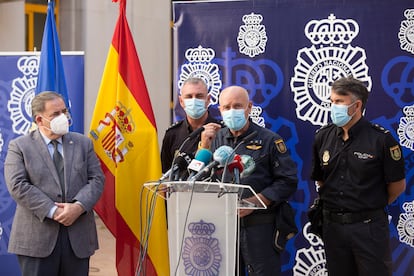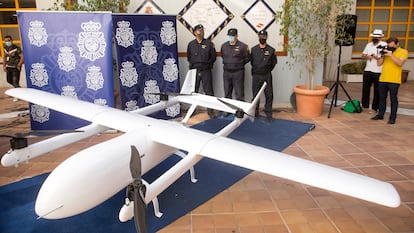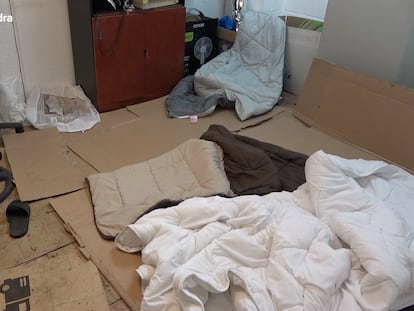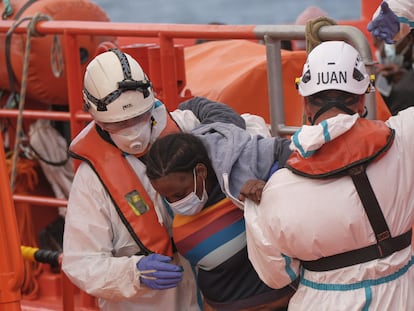Spanish police seize large drone used to carry drugs from Morocco
The aircraft, which has a wingspan of 4.5 meters and seven hours of flight autonomy, was able to fly up to 150 kilos of narcotics between the coast of North Africa and southern Spain
White, with a wingspan of 4.5 meters and a capacity to carry 150 kilos of cargo. Those were the characteristics of an enormous drone that was put on show earlier this week by the National Police in the southern Spanish province of Málaga, in the Andalusia region. The latest surprising seizure made by the authorities involves an organization of French drug traffickers who were looking to establish themselves on the Costa del Sol.
The criminal gang used the aircraft to transport drugs from Morocco to the small town of Almáchar (1,811 inhabitants). The drone has the capability to fly for up to seven hours at a maximum speed of 170km/h. As such, its range for transporting narcotics “is huge,” according to Antonio Rodríguez Puertas, the chief inspector in charge of the UDYCO organized crime unit in Málaga.
“We’ve never seen a drone this big used for this purpose,” said Pedro Luis Bardón, from the National Police’s airborne resources unit. “There were some precedents, but not like this. This is the biggest one ever found in Spain.”
Built in China and with a cost of anywhere between €30,000 and €150,000, depending on its technical characteristics, the drone has five motors. Four of them are electric and allow the aircraft to land and take off vertically. The fifth, a two-cylinder combustion engine, allows for horizontal flight.

The drone can reach altitudes of 2,000 meters (around 7,000 feet), but in general would fly much lower in order to save fuel and avoid detection. However, the aircraft does appear on radar and its electromagnetic communications can also be tracked. These are two of the factors that the police used to confirm the existence of the device. The inside of the aircraft is hollow, and would normally be used for cameras or other electrical equipment. In the case of the drug gang, it was being used for packages of narcotics, particularly cocaine, which brings in the biggest profits.
“Technology makes our lives easier, but it also ends up in the hands of the bad guys,” said the Málaga police chief, Roberto Rodríguez Velasco. “They innovate and we have to do so too.” Also in the province of Málaga, last year Udyco located a nine-meter-long semi-submersible vessel that was going to be used to smuggle tons of drugs at a time and was estimated to have cost €1 million.
The drug gang was flying the drone using an electronic system that relayed the exact takeoff and landing points, and used waypoints – i.e. places during the flight where it had to change course. It could also be flown using remote control. The police reported, however, that the criminals did not have much training or knowledge for its use. This fact, combined with the large size of the aircraft, meant it posed a considerable danger to other air traffic – even for passenger planes.
The drone can be dismantled to facilitate its transport, and was located by the authorities in a house being used as a storage location for narcotics outside Almáchar in the Axarquía area. The zone has a lot of isolated homes, something that is taken advantage of by drug gangs to operate unnoticed.
Operation Piñas, which led to the seizure of the drone, began last month when Udyco detected the French gang, who were also being tracked by police in their home country. Four people were arrested in the operation – three in France and a fourth in Almáchar. In total, 30 kilograms of marijuana and 55 of hashish were found during the operations in Spain and France.
“The fight against drug trafficking is one of our priorities,” said the sub-delegate for the central government in Málaga, Teófilo Ruiz, who added that in 2020, the National Police seized 27.5 tons of narcotics in the province, breaking up 55 criminal groups and detaining 695 people suspected of involvement in trafficking.
English version by Simon Hunter.
Tu suscripción se está usando en otro dispositivo
¿Quieres añadir otro usuario a tu suscripción?
Si continúas leyendo en este dispositivo, no se podrá leer en el otro.
FlechaTu suscripción se está usando en otro dispositivo y solo puedes acceder a EL PAÍS desde un dispositivo a la vez.
Si quieres compartir tu cuenta, cambia tu suscripción a la modalidad Premium, así podrás añadir otro usuario. Cada uno accederá con su propia cuenta de email, lo que os permitirá personalizar vuestra experiencia en EL PAÍS.
¿Tienes una suscripción de empresa? Accede aquí para contratar más cuentas.
En el caso de no saber quién está usando tu cuenta, te recomendamos cambiar tu contraseña aquí.
Si decides continuar compartiendo tu cuenta, este mensaje se mostrará en tu dispositivo y en el de la otra persona que está usando tu cuenta de forma indefinida, afectando a tu experiencia de lectura. Puedes consultar aquí los términos y condiciones de la suscripción digital.
More information
Últimas noticias
Most viewed
- Sinaloa Cartel war is taking its toll on Los Chapitos
- Oona Chaplin: ‘I told James Cameron that I was living in a treehouse and starting a permaculture project with a friend’
- Reinhard Genzel, Nobel laureate in physics: ‘One-minute videos will never give you the truth’
- Why the price of coffee has skyrocketed: from Brazilian plantations to specialty coffee houses
- Silver prices are going crazy: This is what’s fueling the rally












































